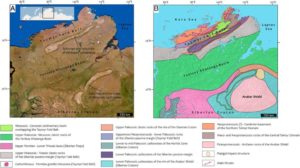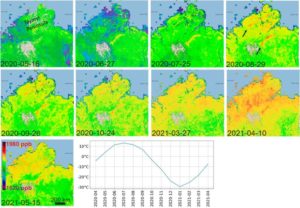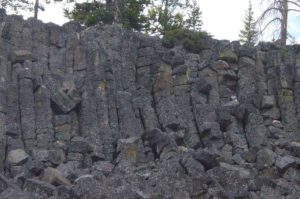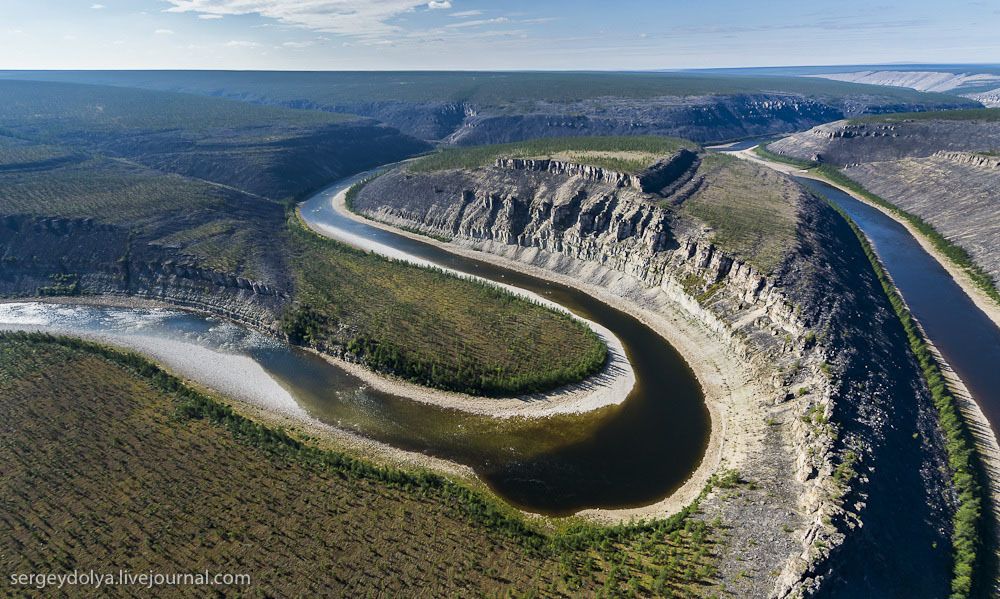The Threat of Thawing Permafrost: Further impetus to remineralize the Earth
Photo by Sergey Dolya, sergeydolya.livejournal.com
A subterranean threat
A new study, published by a team of geologists at the University of Bonn, has presented scientists with a new worry: thawing permafrost. In the past year, the Taymyr Peninsula in Northern Siberia recorded its hottest summer to date. From May 2020 to March 2021, arctic temperatures rose a whopping 6°C above the typical 1967-2000 baseline. While this rising temperature alone is cause for concern, the deeper issue lies below the Earth’s surface.

Geology of the Taymyr Peninsula in North Siberia. (A) Satellite image (ArcGIS World Imagery). Carbonate rock formations on both sides of the Yenisey-Khatanga Basin visible as light-colored stripes. Outlines of atmospheric methane concentration anomalies (Fig. 1) indicated as yellow dashed lines. (B) Simplified geological map (modified from ref. 8). Note close coincidence of carbonate formations and methane anomalies. Image and caption courtesy of PNAS. (Click to enlarge.)
The Taymyr Peninsula is coated with an impermeable layer of permafrost about 700m thick – approximately the length of six football fields stacked on top of each other. Ice-bonded permafrost in this region acts as a reservoir, sealing methane and other gases deep within the rocks. While this thick layer of ice typically prevents any gas from leaking into the atmosphere, an increase in the surface temperature – such as the one observed in 2020 – can cause shallow rocks to fracture. When this happens, the once-impenetrable ice shield becomes plagued by “vents,” allowing subsurface gas to mobilize to the surface (1).
This underscores a frightening reality that scientists are just starting to uncover: As global temperatures rise and permafrost thaws, methane and other harmful green-house gases (GHGs) will be released from the rock stores to the atmosphere. But just how much gas is stored in these arctic rocks is unknown, and this calls for immediate scientific investigation.
break
Observing and understanding the effects of thawing permafrost
Geologists conducted a study from May 2020 to August 2021 to evaluate the positive (increasing) feedback loop between rising temperatures and increased methane gas concentration. Over the course of the year during and after the 2020 heatwave, scientists observed two conspicuous stripes of high methane concentration over northern Siberia. Satellite images revealed these two stripes to be in parallel, and each was several hundred kilometers long. While the origin of these mysterious stripes was not immediately clear, the team hypothesized that there was a critical link between the rising temperatures and rock formations in the area – specifically two outcrops (exposed rocks due to erosion) and subcrops (buried rocks) of rock carbonates situated parallel to each other (1).
These locations – at the northern and southern borders of the Yenisey-Khatanga Basin – typify a hydrocarbon-bearing sedimentary region, which contain unknown amounts of gas hydrates within this permafrost zone. The scientists’ observations revealed an almost perfect correlation between the stripes of these carbonate rocks and the stripes of methane concentration that appeared from May 2020 to March 2021. With high certainty, the scientists believe that the increase in atmospheric methane occurred from thawing permafrost that covers these rocks (1).
break
An alarming precedent has been set
In just over the course of one year, the methane concentrations increased substantially. When the first southern stripe appeared, its methane concentration was about 1800 parts per billion (ppb), while the concentration in the surrounding area was lower. But by April 2021 – less than a year later – the two stripes morphed into one amorphous monolith; almost the entire area recorded concentrations of 1900 ppb, approximately the same concentration of the very first stripe (1).
This finding portends a dangerous trend for the future. As temperatures continue to rise, gas hydrates stored in the permafrost zone are likely to become unstable. It is thought that gas hydrates in the Earth’s permafrost contain about 20 parts per million (ppm) of carbon, which is approximately four times the amount present in atmospheric methane (2).
break
A double whammy: Two sources of methane release
The harmful properties of methane and other GHGs have been well-documented and recognized by geologists and climate scientists. While CO2 makes up most of the GHGs in the US, methane is a far more potent agent, warming the planet at an alarming rate (3).

Atmospheric methane concentrations in North Siberia during 2020–2021, from PULSE map (https://pulse.ghgsat.com/). Note two elongated maxima of methane concentration (arrows) coinciding with carbonate outcrop areas (Fig. 2), and region-wide concentration increase in March to April 2021. See Fig. 2 for location. Curve shows monthly means of 2-m temperature in Siberia (55°N–76°N, 70°E–180°E) during the study period (https://climatereanalyzer.org/). Image and caption courtesy of PNAS. (Click to enlarge.)
The biggest sources of methane in the world are agricultural (3). Methane pollution is typically thought of as a necessary by-product of modern agriculture. This is true for microbial methane, which is methane gas released from microbial decay in soil (1). This is compounded by modern day agricultural practices, which use methane as an input in the harmful Haber-Bosch process (5). This technique relies on high temperature and high pressure to break hydrogen atoms from fossil fuels, converting nitrogen in the air to a form of ammonia that plants can absorb. This method made it possible to produce the synthetic fertilizers we use today – at a cost: further fueling climate change (5).
The recent results of the 2021 study hint at the possibility that thawing permafrost may release two forms of methane: microbial methane from formerly frozen soils, as well as thermogenic methane from permafrost reservoirs. This is a dangerous possibility, especially when we consider that there may be much higher amounts of thermogenic methane (released from rock formations) than microbial methane. According to the researchers, “It is still unknown how fast methane from these subpermafrost sources can be transferred to the atmosphere” (1). This research is urgently needed.
break
A Call to Action: Remineralize and Invest in NETs
Until this estimate can be more accurately known, we need to invest in reactive and preventative measures. A viable option is net emissions technologies (NETs); NETs provide a range of techniques that function to capture, store, and reduce GHGs. Remineralization is one such technique, which uses rock dust and sea minerals to support soil microbes and makes it possible for plants to absorb nitrogen without the harmful methane requirements of the Haber-Bosch process. Remineralize the Earth has shown rock dust to be a functional, efficient, and effective method in agriculture, rejuvenating soils and pulling carbon from the atmosphere (5).

Basalt rocks. Photo by Daniel Mayer under Creative Commons license.
Remineralization and enhanced weathering are critical components of efforts to slow and reverse the effects of climate change. Soil acts as a natural carbon sink; applying rock dust to depleted soils speeds up the process by which the soils can capture CO2 from the atmosphere and store it. Such a methodology alone will not stop the release of microbial and thermogenic methane from arctic permafrost. However, it can help us to reduce methane used in agriculture, which contributes to the positive feedback loop between rising temperatures and GHGs (5).
We are currently caught in a vicious cycle. Methane in the atmosphere spurs a rise in temperature, which further makes permafrosts thaw, carbonates crack, and methane mobilize to the surface. And the cycle continues, catalyzing more warming and methane release.
Reducing the agricultural source of methane is a critical step to altering the positive feedback loop. If we lessen the opportunities for methane use and release, we can slow the rising temperatures. Remineralization is an action we can take now, and it is one that can give us hope that temperatures will stabilize, thereby keeping methane sealed in ice, frozen in place.
break
Meghan Wilcoxon is currently a doctoral student studying cognitive science at Brown University. She was a winner of the Hyundai Visionary Challenge for 2018-2019. She is a Quantitative Researcher and Analytical Writer for the Brown University Virtual Environment Navigation Lab.
break
References
1: Froitzheim, Nikolaus, Jaroslaw Majka, and Dmitry Zastrozhnov. “Methane release from carbonate rock formations in the Siberian permafrost area during and after the 2020 heat wave.” Proceedings of the National Academy of Sciences 118, no. 32 (2021).
2: University of Bonn. “Thawing permafrost releases greenhouse gas from depth.” Phys.org, August 2, 2021. Accessed September 10, 2021. https://phys.org/news/2021-08-permafrost-greenhouse-gas-depth.html, (2021).
3: Mufson, Steven. “Scientists expected thawing wetlands in Siberia’s permafrost. What they found is ‘much more dangerous.’” Seattle Times, August 2, 2021. Accessed September 10, 2021. https://www.seattletimes.com/nation-world/scientists-expected-thawing-wetlands-in-siberias-permafrost-what-they-found-is-much-more-dangerous/.
4: Friedman, Lisa. “Biden implores world leaders to take action on climate change: ‘We don’t have a lot of time.’” The New York Times, September 17, 2021. Accessed September 20, 2021. https://www.nytimes.com/2021/09/17/us/politics/biden-climate-forum.html?campaign_id=9&emc=edit_nn_20210917&instance_id=40616&nl=the-morning®i_id=90097825&segment_id=69157&te=1&user_id=8dab9985cff97eaf0b1c3e1bffde430a.
5: Patskowski, Debbie. “Prof. David Manning on Rock Dust: Quarries, Breweries and Beyond.” Remineralize the Earth, March 21, 2021. https://www.remineralize.org/2021/03/prof-david-manning-on-rock-dust-quarries-breweries-and-beyond/
Support us on Patreon
Thank you for joining us today! Please become a member of RTE and support us on Patreon. Unlike many larger organizations, we work with a team of determined and passionate volunteers to get our message out. We aim to continue to increase the awareness of remineralization to initiate projects across the globe that remineralize soils, grow nutrient dense food, regenerate our forests’ and stabilize the climate – with your help! If you can, please support us on a monthly basis from just $2, rest assured that you are making a big impact every single month in support of our mission. Thank you!








Got something to say?